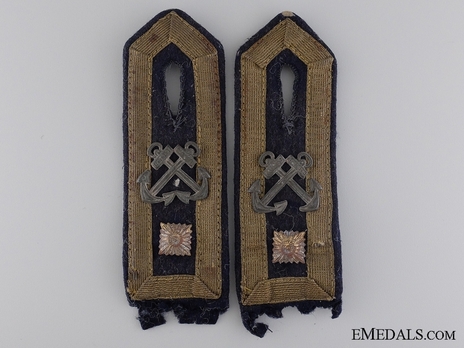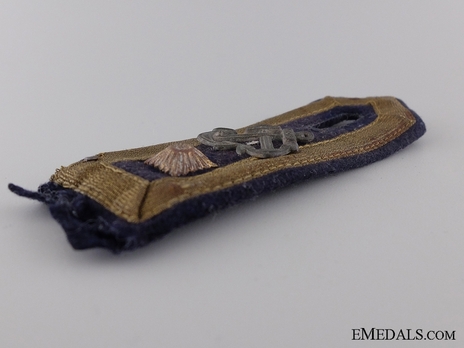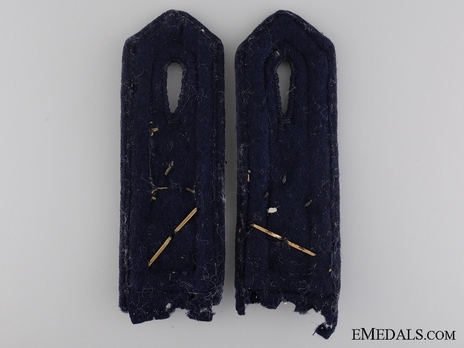Kriegsmarine Helmsman/Coxswain Feldwebel Shoulder Board
CATEGORY: Version
SKU: 21.GOR.03.02.02.04.004.001
Estimated market value:



Estimated market value:
Navy blue wool upper with a 9.5 mm wide strip of fine gold bullion encircling the silvered Helmsman/Coxswain crossed anchors insignia, gilt rank pip and button hole, backer in navy blue wool, severed at the neck end, 38 mm x 108 mm each, exhibiting wear, moderate soiling and scattered mothing, better than fine.
The headgear, uniforms, and insignia worn by members of the Kriegsmarine were based upon the designs utilized by the Kaiserliche Marine (Imperial Navy) and the Reichsmarine of the Weimar Republic. The official regulations governing the uniforms of the Reichsmarine were issued on April 5, 1921, and they were embraced, with a few alterations, as the Kriegsmarine uniforms in 1935.
The first regulations concerning the shoulder boards of officers were issued in 1933, but they were altered several times throughout the interim years and during the war.
Shoulder boards or straps were first and foremost used to identify a soldier’s rank. In certain cases they would also identify the soldier’s branch and unit, and potentially his specific role/career.
Shoulder straps were worn by lower ranks, whereas shoulder boards were worn by higher ranks. The difference lies in the quality of the material, the more elaborate look of the shoulder boards, and the fact that shoulder boards were padded and therefore more stiff, while shoulder straps generally were not. For the sake of simplicity, the terms will be used interchangeably.
Shoulder straps differ in size due to varying production methods and materials, the amount of pips and cyphers they have to hold, and even the wearer’s shoulder size.
The Kriegsmarine shoulder boards were manufactured in three distinct styles, sew-in, slip-on, and pass-through. The boards on the tropical uniform were generally button-on.
The Kriegsmarine used four different uniform types, distinguishable by colour. The shoulder boards will differ from each other depending on what type of uniform they were intended for. The main uniform was navy blue in colour and features shoulder boards with a dark blue underlay. Shoulder boards for the white uniform are very similar, except that they have a white underlay. The brown tropical uniform and the field-grey uniform used mostly by Coastal Artillery units came with shoulder boards that somewhat differed from those of the blue and white uniforms, and will be covered towards the end of this description.
In the Kriegsmarine, shoulder boards were used by soldiers of every rank. An exception were the lowest ranks, the Enlisted Men (EMs), known collectively as Matrosen (seamen), who were only issued shoulder boards with the field-grey uniform and, on occasion, the tropical brown uniform.
Senior NCOs wore metal career insignia cyphers with the blue uniform. However, with the field-grey uniform they wore unit insignia cyphers, which were embroidered in golden-yellow thread. An exception were armourers who kept wearing their career insignia cyphers. With the brown tropical uniform they wore either the career or the unit insignia, depending on which uniform the brown uniform was worn in lieu of.
Senior NCO shoulder strap career insignia cyphers are as follows:
Administrative: mercurian staff on anchor. Before 1935: letter V on anchor, and Material Administration had letter M on anchor
Aircraft Warning: wing over four lightning bolts on anchor
Artillery Mechanic: two crossed gun barrels over cog wheel on anchor
Blocking Weapons Mechanic: mine over cog wheel on anchor
Boatswain: fouled anchor
Carpenter: downward pointing compass on anchor
Clerical: two crossed feathers on anchor
Coastal Artillery: winged flaming shell on anchor
Engine Personnel: cog wheel on anchor
Helmsman/Coxswain: two crossed anchors
Medical: horizontal caduceus on anchor
Motor Transport: steering wheel on anchor
Musician: lyre on anchor
Navigating Helmsman: sextant on two crossed anchors
Ordnance: two crossed gun barrels on anchor
Radio Operator: lightning bolt on anchor
Replacement Service: unfouled anchor
Signals: two crossed signalling flags on anchor
Teletypist: two crossed lightning bolts on anchor
Torpedo Mechanic: torpedo over cog wheel on anchor
The shoulder boards for both senior and junior NCOs feature tress around the edges. It is gold-coloured for shoulder boards for the blue and white uniforms, and matte gold-coloured for the field-grey uniform. On shoulder boards for the brown tropical uniform, a trimming of cornflower-blue ribbon was used, although some had the gold-coloured tress of the field-grey uniform, albeit contrary to regulations..
In addition to the tress, Stabsoberfeldwebel wore three pips, one above and two below the insignia; Oberfeldwebel wore two pips, one above and one below the insignia; Stabsfeldwebel wore two pips, side by side, below insignia; Feldwebel wore one pip.
The shoulder board for the junior NCO rank of Obermaat features tress around the entire outer edge. Those for the rank of Maat feature tress around the outer edge, except for the bottom.
The shoulder boards for Matrosen, the enlisted men, are in the same style as those of Maat and Obermaat ranks shoulder boards, but without any tress.
Shoulder boards for the field-grey uniform had field-grey or dark blue-green badge cloth. Unit insignia cyphers were embroidered in golden-yellow thread for lower ranks, but made of gold-coloured metal for senior NCO ranks. Only armourers wore career insignia cyphers. Several wartime units wore no unit insignia cyphers at all.
Unit insignia cyphers for the field-grey uniform were as follows:
Coastal Artillery Battalions: two crossed unfouled anchors with a Roman numeral battalion number above. Changed in March of 1939 to one unfouled anchor with a superimposed winged flaming shell, with an Arabic numeral battalion number above.
Ship Cadre Battalions: two crossed unfouled anchors with either the Latin letter O or N above (for Ostsee = Baltic Sea, or Nordsee = North Sea). Changed in March of 1939 to two crossed unfouled anchors with an Arabic numeral battalion number above.
NCO Instruction Battalions: two crossed unfouled anchors without a number. Changed in March of 1939 to one fouled anchor with an Arabic numeral battalion number above.
Special (Disciplinary) Battalions:
Cadre personnel: two crossed unfouled anchors; EMs: same, with an additional Latin letter S above.
Aircraft Reporting Detachments: two crossed unfouled anchors with a superimposed wing with four four lightning bolts, with an Arabic numeral battalion number above.
Shoulder boards for the brown tropical uniform were in the style of the field-grey uniform shoulder boards, but with a brown underlay. Officers’ boards were made of matte grey cords. NCO tress is cornflower blue. By April of 1942, the shoulder boards of the blue uniform were prescribed for the brown tropical uniform in order to save material.

Comments
Sign in to comment and reply.


Scroll Top